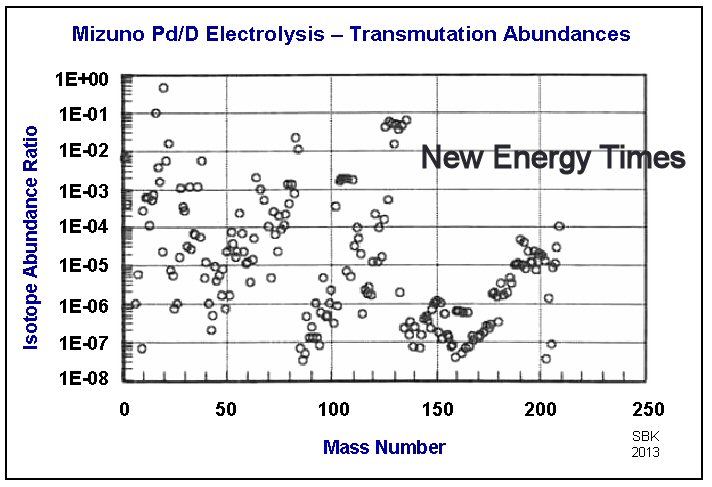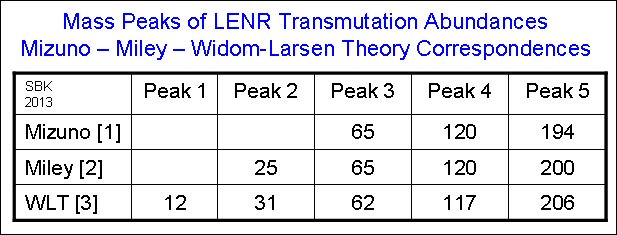LENR Archives Illuminate Scientific Mystery of Century – Part 2

Feb. 22, 2013 – By Steven B. Krivit –
[This is Part 2 of a Four-Part Series. Part 1 published on Feb. 20.]
This is the continuation of a review of selected papers from the first decade of LENR research. This article continues with research from 1996.
ICCF-6 Conference (1996)
Tadahiko Mizuno, Tadayoshi Ohmori, Tadashi Akimoto, Kazuya Kurokawa, Masatoshi Kitaichi, Koichi Inoda, Kazuhisa Azumi, Shigezo Simokawa and Michio Enyo, “Isotopic Distribution for the Elements Evolved in Palladium Cathode After Electrolysis in D2O Solution”
In this paper, Tadahiko Mizuno, now the director of Hydrogen Engineering Application and Development Co. in Sapporo, reported one of the most distinctive before-and-after elemental analyses of LENR transmutations in the field.

LENR Transmutation by Tadahiko Mizuno
[DAP errMsgTemplate=”” isLoggedIn=”N”]
_____ Article continues for subscribers. Click here to subscribe. _____
[/DAP] [DAP errMsgTemplate=”” isLoggedIn=”Y”]
He also saw the unique grouping of mass abundances from heavy-hydrogen LENR experiments that became well-known for its similarity to George Miley’s mass abundances from light-hydrogen LENR experiments.

Mizuno LENR Transmutation Abundances
Mizuno saw four distinct peaks.
“Elements are mostly grouped in four ranges of mass number: lightest elements under mass 50, light elements from 50-80; middle elements from 100-140; and heavy elements from 180-208,” he wrote.
In Mizuno’s paper, where he identified a range for the peaks he observed, they equate to mass numbers 65, 120 and 194.
In his conclusion, he anticipated the most common skeptical speculation.
“It can hardly be imagined that all of the elements found were impurities in electrolyte, electrode or cell. Even if we suppose that all impurities in the system accumulated in the cathode, the amount would be 10 to 100 times smaller than the total amount we detected. Furthermore, it is simply impossible to explain the shifts in the isotopic distribution. Therefore, it must be concluded that some novel reactions occurred, resulting in the reactants which were found abundant in the electrolyte and electrode material,” Mizuno wrote.
Mizuno also maintained an open mind about the possible materials that contributed to the reactions; he was not constrained by the heavy-hydrogen-and-palladium ideology that was dominant in the field from the late-1990s to the late-2000s.
“We assume the palladium cathode was the starting material for these reactions, but it is possible that impurities and other cell components such as Li, D2O, Pd, Pt, K, Na, Ca, B, C, Ag and Fe may have provided the starting material for the nuclear reactions,” Mizuno wrote.
George Miley, G. Narne, M.J. Williams, James A. Patterson, J. Nix, Dennis Cravens and Heinrich Hora, “Quantitative Observation of Transmutation Products Occurring in Thin-Film Coated Microspheres During Electrolysis”
At the same 1996 conference, George Miley, a professor of nuclear engineering of the University of Illinois, presented transmutation results that showed a similar multi-peak pattern of elemental abundances. Together, these two papers represent milestones in LENR history.
In his ICCF-6 paper, Miley graphed the abundances by atomic number (Z). But in 1997 and 1998, he published the abundances by atomic mass (A), instead. And in 2000, in his ICCF-8 paper, he specifically identified the ranges of the peaks.
“A striking pattern consistently observed in these measurements is that the high-yield reaction products occur in four mass ranges, roughly A = 20-30, 50-80, 110-130, and 190-210,” Miley wrote.
In Miley’s paper, where he identified a range for the peaks he observed, they equate to mass numbers 25, 65, 120 and 200.
The relationship between Miley’s light-water data and Mizuno’s heavy-water data was well-known in the field. McKubre, for example, mentioned it during his Jan. 9, 2008, talk at the National Institute for Advanced Studies on the campus of the Indian Institute of Science in Bangalore, India.
“Mizuno and Miley,” McKubre said, “you can overlap them and see the same thing.”
If McKubre knew the significance of that coincidence, he never explained it publicly. But Larsen explained it. He knew it meant that the same mechanism, the same non-fusion mechanism, was responsible for both sets of data and that the assertion by “cold fusion” believers that distinct processes took place in the light- versus heavy-hydrogen LENR work was mistaken. When Widom and Larsen published their theory in 2006, they used it to calculate the predicted peaks: 12, 31, 62, 117 and 206.

Mizuno – Miley – Larsen – LENR Mass-Peak Correspondance
1. Mizuno, Tadahiko, et al., “Isotopic Distribution for the Elements Evolved in Palladium Cathode After Electrolysis in D2O Solution,” Proceedings of the Sixth International Conference on Cold Fusion
2. Miley, George H., “On the Reaction Product and Heat Correlation for LENRs,” Proceedings of the 8th International Conference on Cold Fusion
3. Widom, Allan and Larsen, Lewis, “Nuclear Abundances in Metallic Hydride Electrodes of Electrolytic Chemical Cells,” Preprint, February 20, 2006
Melvin H. Miles, “Reply to S. E. Jones and L. D. Hansen Concerning Claims of Miles, et aI. in Pons-Fleischmann-Type Cold Fusion Experiments”
This paper is Melvin Miles’ response to a critical and apparently unscientifically skeptical paper by Steven E. Jones, formerly of Brigham Young University, who was involved in the early controversy with “cold fusion” discoverers Martin Fleischmann and Stanley Pons.
“Steven E. Jones and Lee D. Hansen ignored our previous explanation on many issues that are contained in our publications. Their mixture of facts, distortions, and misunderstandings regarding our work certainly does not facilitate any scientific resolution of the cold fusion controversy,” Miles wrote.
Miles’ depiction of Jones’ behavior is consistent with other historical accounts of Jones’ behavior toward Fleischmann and Pons in 1988, 1989, and in the early 1990s, following the Fleischmann-Pons announcement.
Thomas O. Passell, “Search for Nuclear Reaction Products in Heat-Producing Palladium”
In a field often dominated by electrochemists, Thomas O. Passell was one of the few researchers who had the insight and interest to look at LENRs from the perspective of nuclear chemistry, his discipline.
When he was working with the nuclear power group of the Electric Power Research Institute, Passell used a prompt gamma activation analysis method to search for anomalous isotopic shifts on a cathode that produced half a megajoule of excess heat in a LENR experiment performed by McKubre’s group at SRI International.
He analyzed it for boron-10 and palladium-105 and found an 18% reduction of boron-10 in the post-electrolysis cathode compared to its concentration in the virgin material. Perhaps equally important was the unique value of his analytical method for LENR research.
“The main advantage of PGAA is its ability to observe the entire contents of a sample cathode nondestructively,” Passell wrote. “Most other methods observe a small volume of material near the surface or are destructive in that they consume the sample. Thus, [researchers] need not wonder whether the sampled part of the cathode is representative of the whole or [instead] a local artifact.”
I’m not familiar with any other analytical method that can do this. I also can’t recall whether other LENR researchers in the last decade have used PGAA. Unless, for some reason, the technique is now obsolete, perhaps other researchers might want to consider using it again.
Where many D+D “cold fusion” believers searched only for, and found, helium-4 and speculated that helium-4 alone was the main product of LENRs, Passell looked at the experiments from his unique perspective as a nuclear chemist.
“It is encouraging to note that the 18% depletion in B-10 corresponds almost exactly to the number of reactions of B-10 via the d, alpha reaction to Be-8 needed to explain the 0.56 megajoules of excess heat observed. (2E17 B-10 atoms are missing from a total of 1.2E18 present in the virgin material),” Passell wrote.
Passell was simply looking at the elephant from the other side. McKubre must have known that Passell found isotopic anomalies in his cathode; apparently, he didn’t believe Passell’s data because McKubre never reported it.
Part Three of this series will publish in a few days
Questions? Comments? Submit a Letter to the Editor.

